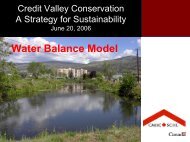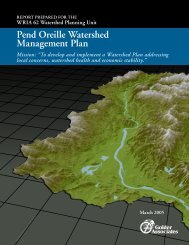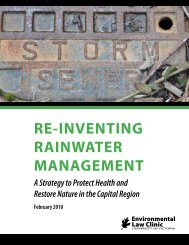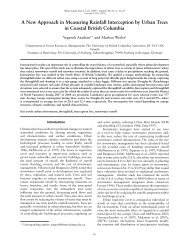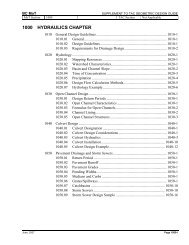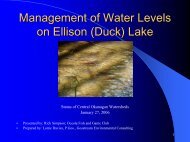Stormwater Source Control Design Guidelines 2005 - Waterbucket
Stormwater Source Control Design Guidelines 2005 - Waterbucket
Stormwater Source Control Design Guidelines 2005 - Waterbucket
Create successful ePaper yourself
Turn your PDF publications into a flip-book with our unique Google optimized e-Paper software.
DESIGN PRINCIPLES■ Maximize the area of absorbentlandscape – either existing orconstructed – on the site. Conserveas much existing vegetation andundisturbed soil as possible.■ Minimize impervious area by usingmulti-storey buildings, narrowerroads, minimum parking, largerlandscape areas, green roof, andpervious paving.■ Disconnect impervious areas fromthe storm sewer system, havingthem drain to absorbent landscape.■ <strong>Design</strong> absorbent landscape areasas dished areas that temporarilystore stormwater and allow it to soakin, with overflow for large rain eventsto the storm drain system.15% CrownInterception8% Stemflow77% ThroughfallPear TreeWinter tree canopies intercept15% to 27% of rainfall.27% CrownInterception15% Stemflow58% ThroughfallEvergreen Oak Tree13In most natural wooded conditions inthe GVRD, 90% of rainfall volumenever becomes runoff, but is eithersoaked into the soils or evaporates /transpirates. Trees, shrubs, grasses,surface organic matter, and soils allplay a role.Variables of Absorbent Landscape1. Crown Interception2. Throughfall and Stemflow3. Evapotranspiration4. Soil Water Storage5. Soil Infiltration6. Surface Vegetation7. Organics and Compost8. Soil Life9. Interflow10. Deep Groundwater11. Water Quality Improvement12. Impermeable Surfaces andSurface Runoff■ Maximize the vegetation canopycover over the site. Multi-layeredevergreens are ideal, but deciduouscover is also beneficial forstormwater management.■ Ensure adequate growing mediumdepth for both horticultural andstormwater needs – a minimum150mm for lawn areas, and 450mmdepth for shrub/tree areas. In wetterclimates with till subsoils, a minimumdepth of 300mm for lawn is requiredto store 60mm of rainfall.2645812■ Cultivate compost into surface soilsto create minimum 8% organicmatter for lawns, and 15% forplanting beds.■ To avoid surface crusting andmaintain surface permeability, installvegetative (grass, groundcovers,shrubs, trees) or organic cover(mulch, straw, wood fibre) as earlyas possible in the constructionprocess, and prior to winter storms.■ Provide effective erosion controlduring construction, includingerosion control on upstream sitesthat may flow into the absorbentlandscape.7Organic matter and soilmicro-organisms are vital tomaintaining soil infiltration rates.11Rainfall storage in soil is 7%to 18% of soil volume.910Infiltration rate (mm/hr)50403020100Straw mulchMulchremovedBaresoilImpermeablesurfaces create8-10 times morerunoff thanabsorbentlandscapes.Burlap MulchMulchremovedBaresoil0 0.5 1 1.5 2 2.5 3Time (hr)Influence of surface cover oninfiltration rate of sandy loamAbsorbent LandscapesGreaterVancouverRegionalDistrict<strong>Stormwater</strong> <strong>Source</strong> <strong>Control</strong> <strong>Design</strong> <strong>Guidelines</strong> <strong>2005</strong>10Goya NganLandscape ArchitectDetailed design guidelines can be found in the <strong>Design</strong><strong>Guidelines</strong> <strong>2005</strong> report, available at www.gvrd.bc.caStraw mulchCompostDemonstration atUniverCityAt SFU's communitydevelopment, a 75mm compostlayer over absorbent soils hasdemonstrated effectiveness inerosion control and runoffinterception. It has alsosupported rapid vegetationestablishment.



